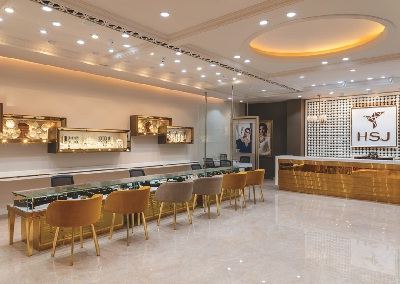Policy changes last year created a lot of upheavals in the Indian gems and jewellery
industry. A good medicine tastes bitter; likewise, the policies may have caused
a short-term mayhem in the industry, however, the gradual transition with GST is
meant to do good in the long term. It’s definitely a move towards more transparent
and organized way of doing business. By Kavita Parab

GST Since July 2017
After a lot of opposition from various corners, GST finally came into force in July 2017. 3 per cent GST was introduced affecting jewellery demand in the country which dropped to 114.9 tonnes in the third quarter of 2017, says World Gold Council. Large organised players didn’t face much of an issue with their accounting systems in place while the smaller retailers faced a lot of issues with the new tax regime. The new tax regime brought in a shift in the buying preferences of the consumers as more and more buyers are choosing organized players over unorganized ones. Guaranteed purchases, better pricing and transparent sales have helped organized players to amass more sales in the last few months. According to news reports, stock of jewellery companies such as Titan and Tribhovandas Bhimji Zaveri jumped 163 per cent and 100 per cent, respectively, during the previous calendar year.
PMLA Trouble
While the industry was struggling to adapt to GST, the government brought the gems and jewellery industry under the umbrella of the Prevention of Money Laundering Act (PMLA) in late August. As the retailers and consumers were required to submit their KYC documentation for all jewellery transactions with a value of Rs. 50,000 or above, consumers stayed away from gold and jewellery purchases, especially the rural consumers who primarily make transactions in cash. Last October, the Government lifted PMLA from the gems and jewellery industry. Though the act was revoked, the festive season sales, especially Diwali, remained too little. According to estimates, the sales were down by almost 30 per cent during Diwali.
Gem & Jewellery Exports Experience Dip
According to the Gems and Jewellery Export Promotion Council (GJEPC) data, exports stood at US$ 23.56 billion in the same period last year. The labour-intensive sector contributes about 14 per cent to the country’s overall exports. The drop in shipments is mainly due to negative growth in the export of gold jewellery and gold medallions and coins. Industry experts have demanded support for the industry such as incentives under the Merchandise Exports from India Scheme (MEIS) to boost the shipments. “We have asked for support under the MEIS and immediate resolution of GST (Goods and Services Tax) refund issue. Blockage of working capital due to GST is impacting exports,” a GJEPC official, who does not wish to named, said. On December 5, the government extended incentives to sectors such as leather and agriculture with an aim to boost outward shipments that have been disrupted by implementation of the GST. As per the data, gold jewellery shipments during April- November 2017-18 declined by 3.18 per cent to US$6 billion. Export of gold medallions and coins contracted by 50 per cent during the period. However, silver jewellery exports went up by 18.5 per cent to about US$3 billion during the period. Import of gold bars too increased by 5 per cent to US$3.24 billion.

Are we ready for Hallmarking and Caratcount?
Last year, the government announced that it is planning to make hallmarking along with carat count mandatory for the gold jewellery sold in the country. The gold jewellery industry had welcomed the government’s decision but there is still a lot of ambiguity over the hallmarking standards. While it is said that hallmarking will be done for jewellery in 14K, 18K and 22K categories, what will happen to 20K, 23 and 24K that are widely used in our country? The government, so far, has not issued any clarity over this issue as hallmarking regulations are yet to be finalised. Besides, the industry has also insisted on the need to increase the number of hallmarking centres across the country. If reports are to be believed, there are over 500 centres currently and majority of these centres are located in metros. Of the total population of jewellers, which is estimated to be over 5 lakh, only around 40 per cent are in the urban areas. If this is the case, then what about the remaining 60 per cent, who do not have direct or easy access to the hallmarking centres?
Meanwhile, World Gold Council (WGC) has called for phase-wise implementation of hallmarking and carat count, starting with 22 large cities, from Mumbai, New Delhi to Nagpur and Patna. Retailers need to take responsibility for hallmarking in India in the short-term and in the long-term manufacturers should assume responsibility for hallmarking, the WGC report said.
National gold policy for India soon
The Indian government is planning to formulate a National Gold Policy, which will boost India’s jewellery exports. The gems and jewellery exporters fear that the country’s exports may stagnate at US$43 billion if the government doesn’t intervene. India’s gold imports are expected to rise to over 700 tonnes in the current fiscal as against 500 tonnes in 2016-17, said GJEPC. As compared to India’s total import of gold, only about 10 per cent is exported. In order to increase the export numbers and to take the sector to next level of growth, gold policy needs a review. The Centre’s policy think-tank Niti Aayog has already set up a group to formulate such a policy framework. The policy is expected to address issues including standardisation, imports, exchange mechanism for gold and refineries, etc.

IIJS 2017 Concluded on a Successful Note
The Indian gem and jewellery industry heaved a sigh of relief as the 34th IIJS attracted a lot of footfall despite rains hitting Mumbai. There was an increase in number of exhibitors this year – around 1,200. Each day at the event was a good business day for the exhibitors across all categories. With its 34th edition, IIJS this year also marked the beginning of digital transformation by going 100 per cent cashless. The exhibitors at gold jewellery and studded jewellery segment witnessed maximum footfall and did brisk business.
India Moving Towards Organized Retail
The Indian gems and jewellery retail sector continues to be unorganized, where the trust quotient is weighed by the word of a ‘family-jeweller’. Yet, consumers have been made aware of concepts of transparency, standardization and hallmarking, as promoted by the organized trade.
Last year, Denmark-based jewellery brand Pandora opened its store in India. Also, Fabergé launched in India through a franchise store. Taking these examples, the Indian retail canvas in the jewellery sector seems open to brands across parameters of price and taste. It may be noted that India is welcoming leading international brands at a time when the country is growing its organized retail footing.
It would be interesting to measure the preferences of the Indian consumer who is all set to be global. Will the international brands trigger a change for the organized brands to add more global tastes into their collections, or vice versa? Also, will this probably encourage the smaller jewellers to brand themselves in their own small ways, thereby encouraging organized retail?
Be the first to comment